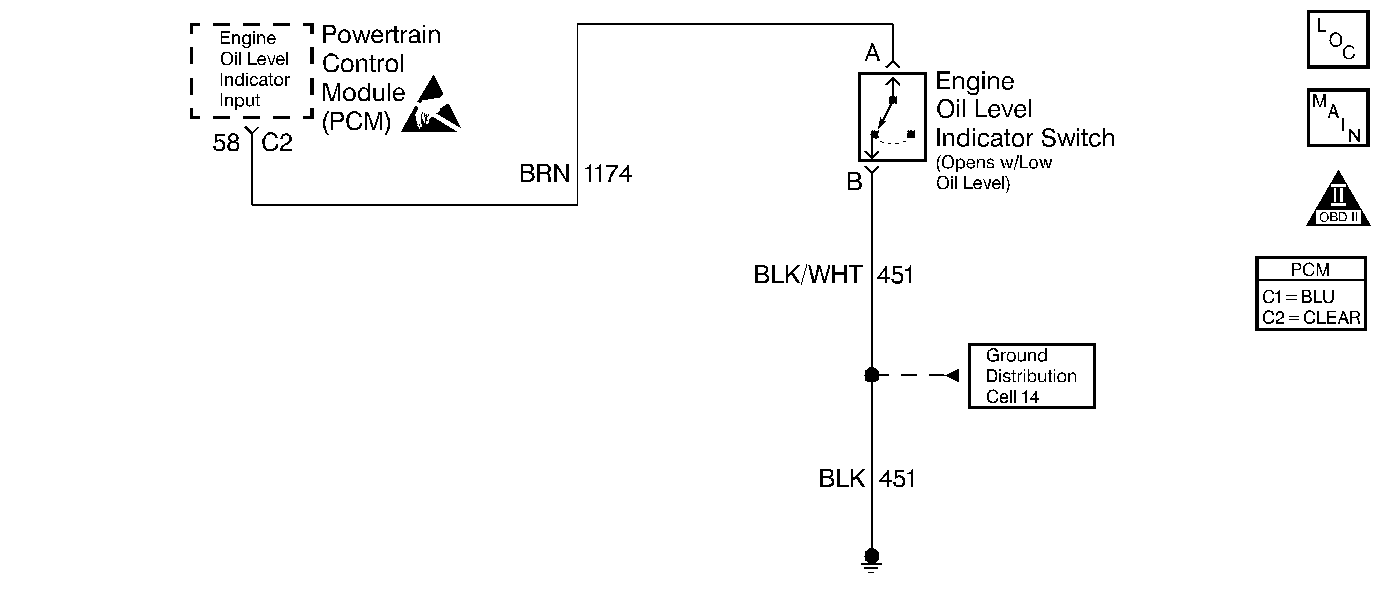
Circuit Description
The engine oil level switch is a simple float switch that is grounded when the engine oil level is OK. The powertrain control module (PCM) tests the engine oil level switch circuit at startup. Before testing the state of the engine oil level switch, the PCM performs a test routine based on time and the engine coolant temperature (ECT) to ensure that the engine oil has drained back into the sump. In order to test for low oil level at startup, one of the following conditions must be present:
| • | If the ECT was between 15°C (59°F) and 130°C (266°F) at the last key off, the engine coolant temperature at key on must be at least 12°C (22°F) cooler than the ECT at the last key off. |
| • | If the ECT was higher than 82°C (150°F) at the last key off, the time between last key off and the present key on must be sufficient to allow the oil to drain back into the sump. The PCM remains powered up for 10 seconds to ensure that the oil has drained back into the sump. If the key is turned back on while the PCM is still powered up, the oil level is not tested. |
The low oil level lamp is illuminated for approximately 7 minutes when the PCM tests for low oil level and the engine oil level switch indicates that a low oil level condition exists. When the ignition is first turned on, the PCM commands the low oil level lamp on for a brief period of time in order to test the bulb.
Diagnostic Aids
For diagnosis of the instrument panel, perform the Diagnostic System Check - Instrument Cluster in Instrument Panel, Gauges, and Console.
Inspect for the following conditions:
| • | A faulty connection at PCM or the oil level sensor. Inspect the harness connectors for backed out terminals, improper mating, broken locks, improperly formed or damaged terminals, and faulty terminal to wire connections. |
| • | Inspect the wiring harness for damage. If the harness appears to be OK, disconnect the PCM and turn the ignition on. Observe a voltmeter connected to the affected PCM output circuit while moving the connectors and wiring harnesses related to the PCM output circuit. A change in voltage indicates the location of the fault. |
Test Description
The number(s) below refer to the step number(s) on the Diagnostic Table.
-
This vehicle is equipped with a powertrain control module (PCM) which utilizes an electrically erasable programmable read-only memory (EEPROM). When the PCM is replaced, the new PCM must be programmed.
-
For the PCM to test the engine oil level, the startup engine coolant temperature must be at least 12° C (22° F) cooler than the engine coolant temperature was the last time the ignition was turned off. Allowing the engine to warm and then cool ensures that the PCM tests the engine oil level switch and that the information displayed on the scan tool is current.
Step | Action | Value(s) | Yes | No |
|---|---|---|---|---|
1 |
Important: Ensure that engine oil level is not low, as indicated on the engine oil level indicator, before continuing diagnosis. Was the On-Board Diagnostic System Check performed? | -- | ||
2 | Use a scan tool in order to observe the Engine Oil Level display. Does the engine oil level display OK? | -- | Go to Diagnostic Aids | |
3 |
Does the test lamp illuminate? | -- | ||
4 |
Is the voltage near the specified value? | B+ | ||
5 | Connect the DMM between the engine oil level switch signal circuit and chassis ground. Is the voltage near the specified value? | B+ | ||
6 |
Was a problem found? | -- | Go to Diagnostic Aids | |
7 |
Was a problem found? | -- | ||
8 |
Was a problem found? | -- | ||
9 | Locate and repair an open in the engine oil level switch ground circuit . Refer to Wiring Repairs in Wiring Systems. Did you complete the repair? | -- | -- | |
10 | Replace the engine oil level switch. Refer to Engine Oil Level Indicator Switch Replacement . Did you complete the repair? | -- | -- | |
|
Important: The replacement PCM must be programmed. Refer to Powertrain Control Module Replacement/Programming . Replace the PCM. Did you complete the repair? | -- | -- | ||
Is the Engine Oil Level display OK? | -- | System OK |
